In a cosy suburban home, a love story unlike any other was unfolding. Yogi, a rambunctious pitbull puppy with fur the colour of burnished caramel, bounced through life with infectious enthusiasm. His days were filled with boundless energy, clumsy attempts at chasing butterflies, and the occasional tumble over his paws. But everything changed the day Willow arrived.

Willow, a tiny human wrapped in a blanket the colour of a summer sky, entered the world with a squall and a wrinkled brow. Her arrival meant a whirlwind of activity – hushed voices, unfamiliar smells, and a constant stream of visitors cooing over her delicate features. Yogi, always curious, couldn’t help but be drawn to the source of all the commotion.

The first time Yogi met Willow, he approached cautiously, his tail thumping a nervous rhythm against the floor. Willow, nestled in her crib, gurgled and reached out a chubby hand. Yogi, hesitant at first, tentatively sniffed her fingers. A giggle erupted from Willow, a sound so sweet it melted Yogi’s apprehension. From that day on, an unbreakable bond began to form.
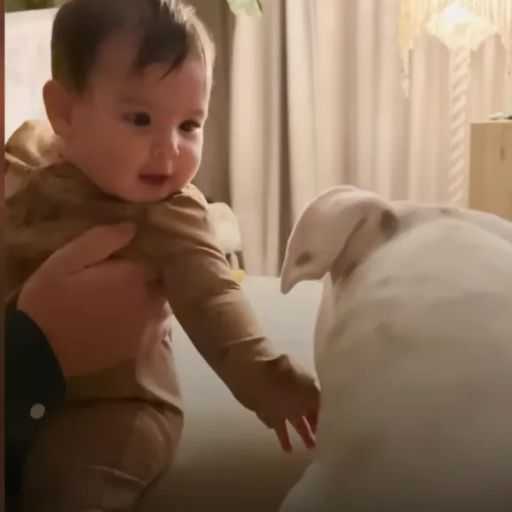
As Willow grew, so did their friendship. Yogi, no longer a clumsy puppy, blossomed into a gentle giant. He learned to temper his boisterousness, his playful nips replaced with soft licks. He became Willow’s constant companion, following her around the house with a watchful eye. Willow, in turn, thrived under his watchful gaze. Her laughter echoed through the house as Yogi patiently endured her attempts to climb onto his back, his broad back a sturdy platform for her explorations.
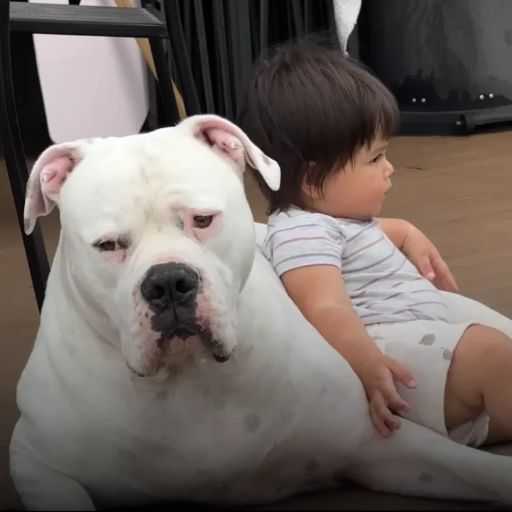
Their days were filled with simple joys. They spent lazy afternoons sprawled on a sunny porch, Yogi’s warmth a comforting presence as Willow babbled to herself. They explored the backyard, Willow clutching a daisy chain she’d painstakingly created while Yogi sniffed at every intriguing scent. Mealtimes were an adventure, with Willow flinging bits of cereal that Yogi would delicately catch in mid-air.
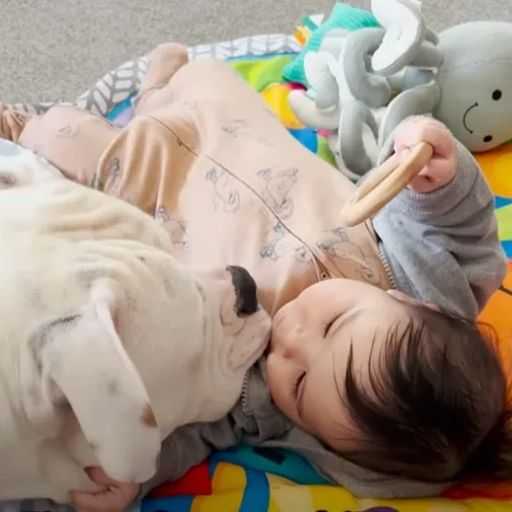
One crisp autumn afternoon, as leaves swirled in a colourful dance, Willow took her first wobbly steps. With a determined look on her face, she reached out for Yogi’s fur. He lowered himself patiently, allowing her to grip his soft fur as she took a tentative step forward. A triumphant squeal escaped Willow’s lips as she took another step, then another, all with Yogi’s unwavering support by her side.
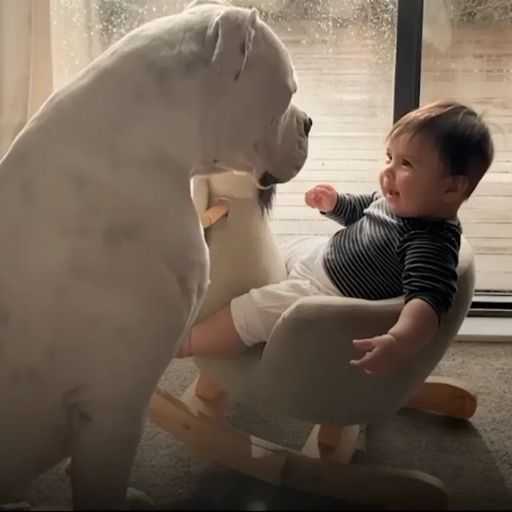
As the years rolled by, their bond deepened. Willow blossomed into a curious and energetic child, her world a playground of endless possibilities. Yogi, ever the patient companion, was always there to share in her adventures. They built sandcastles on sunny beaches, their laughter blending with the sound of crashing waves. They chased fireflies in the twilight, their silhouettes dancing amongst the tall grass.
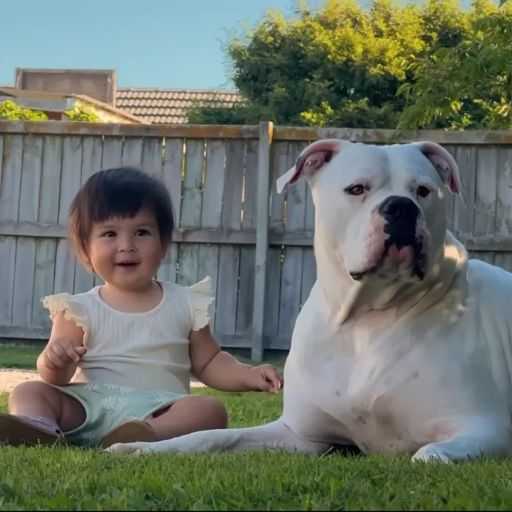
One rainy afternoon, Willow, now a pre-teenager, sat curled up on the couch with a book, a frown etching lines on her forehead. Yogi, sensing her distress, nudged his head into her lap. Willow sighed, burying her face in his fur. The warmth of his presence and the gentle rhythm of his breath chased away her worries. In that moment, Yogi was more than just a pet; he was a confidant, a furry therapist providing unconditional love and support.

Their bond transcended the typical relationship between pet and owner. It was a friendship built on mutual trust, unwavering loyalty, and a deep understanding that transcended words. Yogi, the once rambunctious puppy, had become Willow’s protector, her confidant, and her furry shadow. Willow, in turn, showered Yogi with love, and affection, and the occasional treat slipped from the dinner table.
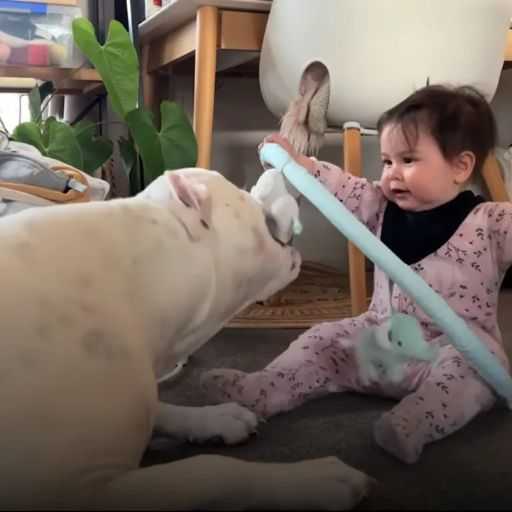
Their story wasn’t just about playtime and adventures; it was about the profound connection that can blossom between a child and a pet. It was a testament to the unwavering loyalty and unconditional love that dogs offer, and the joy and comfort they bring into our lives. Yogi and Willow, an unlikely pair bound by an unbreakable bond, were living proof that love comes in all shapes, sizes, and sometimes, with wagging tails and wet noses.

Watch The Full Video Here:
Ever wondered how your furry companion perceives the world around them? Understanding how dogs see color is like peering into their unique visual universe. As a seasoned dog trainer, you’re constantly observing their behaviors and reactions, but have you ever considered the role of color in their daily experiences? It’s a fascinating aspect that sheds light on their perspective and interactions with the environment.
When you witness your dog’s excitement at the sight of a vibrant toy or their confusion with certain objects, it’s easy to ponder if color plays a part in their reactions. Exploring this topic not only deepens your bond with your canine friend but also provides valuable insights into their sensory world. So, let’s take a closer look at the colorful realm as perceived through your dog’s eyes.
Understanding Canine Vision
Let’s dive into how your furry friend sees the world. Dogs perceive fewer colors than humans. While you enjoy a rainbow, your pooch sees mainly blues and yellows. Their world lacks the richness of reds and greens, but shines in shades of blue and yellow instead.
Did you know that dogs have more rod cells in their eyes than humans do? Rod cells help with sensing light and movement. This means your dog is brilliant at seeing in low light conditions. They excel in dusk and dawn, navigating the world with ease when it’s dim outside.
Ever wondered why your dog seems unfazed by your colorful outfit choices? It’s because they focus more on brightness and contrast rather than the actual color. So, feel free to dress in vibrant hues – your pup will still think you look fabulous!
Understanding your pet’s vision can help you create a stimulating environment for them. Opt for blue or yellow toys for better visibility. Knowing how they see the world can enhance your interactions and enrich your bond with your faithful companion.
How Dogs Perceive Colors
Dogs mainly see blues and yellows. They have more rod cells in their eyes than cones, which impacts their color vision. This means they see fewer colors than humans.
Their vision is similar to red-green color blindness in humans. They see the world in shades of blue and yellow, making it hard for them to distinguish between red, green, and orange objects.
Bright colors like red may appear more muted to dogs, while blues and yellows stand out. In low light conditions, they rely on movement and brightness rather than color.
Creating a stimulating environment for your dog involves using blue or yellow toys that catch their attention. Understanding their color perception helps improve interactions and bonding with your furry friend.
Studies and Research Findings
Digging into studies and research on how dogs see color sheds light on their unique visual perception. Researchers at the University of Washington found that dogs perceive the world in predominantly blues and yellows due to their specific eye anatomy. This means that colors like red, green, and orange may appear less vivid to our furry friends.
An interesting study led by scientists at the Russian Academy of Sciences revealed that while dogs may not see the world in the same vibrant hues as humans, they excel in detecting motion and contrast. Dogs prioritize these visual cues over colors, especially in low light conditions.
Further research conducted by the Eötvös Loránd University in Hungary emphasized that dogs’ dichromatic vision influences their ability to distinguish between various colors. Their color perception is akin to red-green color blindness in humans, affecting their ability to differentiate certain shades.
Understanding these research findings can help you better cater to your dog’s visual needs. Opting for toys or accessories in shades of blue or yellow can enhance your pup’s visual experience and make interactions more engaging for them. Being mindful of your dog’s color perception can ultimately strengthen the bond between you and your canine companion.
Factors Affecting Color Perception in Dogs
Rod cells and cone cells in a dog’s eyes determine how they perceive colors. Rod cells help with night vision and motion detection, while cone cells are responsible for color vision. Dogs have more rod cells, making their color vision limited compared to humans.
Color Blindness in Dogs:
Dogs struggle to differentiate between red, green, and orange hues. This is because dogs’ eyes lack certain cone cells that detect these colors. Their vision is similar to red-green color blindness in humans, affecting their ability to see these shades distinctly.
Priority on Movement and Brightness:
In low light conditions, dogs rely more on movement and brightness than color. This means they prioritize detecting motion and contrasting shades rather than specific colors. Understanding this can help you choose toys or objects that are easier for your dog to see and engage with.
Research Insights:
Studies from the University of Washington and the Russian Academy of Sciences confirm that dogs excel in noticing motion and contrast while facing challenges with certain color distinctions. This knowledge can assist dog owners in creating a visually stimulating environment for their furry companions.
Conclusion
So, there you have it – dogs may not see the world in all the colors of the rainbow like we do, but their unique vision has its perks. Their ability to focus on movement and brightness rather than color helps them navigate their surroundings with ease. While they may struggle with certain hues, their keen sense of contrast and motion makes them exceptional companions. Remember, when choosing toys or accessories for your furry friend, opt for shades like blue or yellow to make their visual experience even more enjoyable. Understanding how dogs see color adds another layer to the beautiful relationship between you and your canine buddy.
Frequently Asked Questions
Do dogs see in color like humans?
No, dogs do not see in color like humans. They have limited color vision due to having more rod cells than cone cells in their eyes.
What colors can dogs see best?
Dogs can see best in shades of blue and yellow due to their limited color perception. These colors stand out more to them compared to others.
How do dogs compensate for their limited color vision?
Dogs compensate for their limited color vision by prioritizing movement and brightness over specific colors, especially in low light conditions.
What research supports the findings on dogs’ color perception?
Recent studies from the University of Washington and the Russian Academy of Sciences validate the findings on dogs’ color perception, showing their strength in detecting motion and contrast but struggle with specific color differentiations.

Hey there, I’m Janet Brooks, a dog-loving student from California. I’m all about helping pups in need, especially those without homes. Me and my awesome friends work together to give shelter and love to stray dogs. Oh, and I also write blogs about dogs to share helpful info.